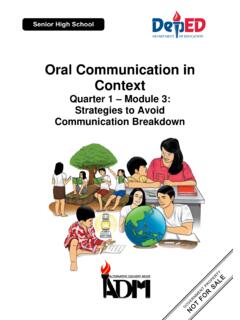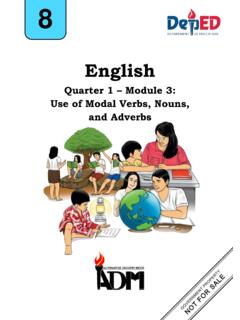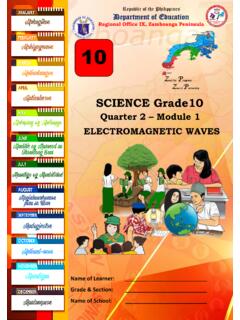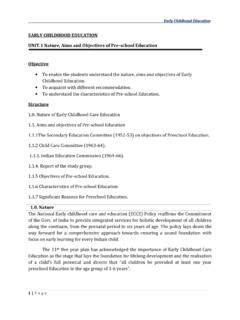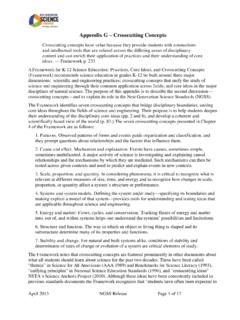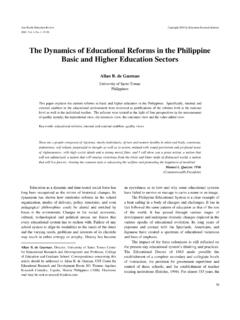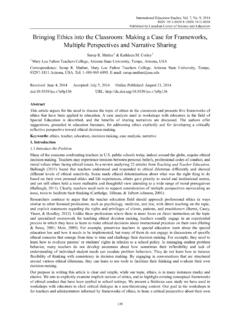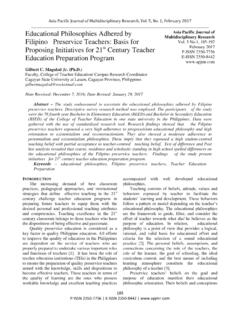Transcription of Biases and Prejudices
1 Republic of the Philippines Department of Education Regional Office IX, Zamboanga Peninsula 9 Zest for Progress Z Peal of artnership English Quarter 3 Module 1. Biases and Prejudices Name of Learner: _____. Grade & Section: _____. Name of School: _____. English Grade 9. Alternative Delivery Mode Quarter 3 Module 1: Biases and Prejudices First Edition, 2020. Republic Act 8293, section 176 states that: No copyright shall subsist in any work of the Government of the Philippines. However, prior approval of the government agency or office wherein the work is created shall be necessary for the exploitation of such work for a profit.
2 Such agency or office may, among other things, impose as a condition the payment of royalties. Borrowed materials ( , songs, stories, poems, pictures, photos, brand names, trademarks, etc.) included in this module are owned by their respective copyright holders. Every effort has been exerted to locate and seek permission to use these materials from their respective copyright owners. The publisher and authors do not represent nor claim ownership over them. Published by the Department of Education Secretary: Leonor Magtolis Briones Undersecretary: Diosdado M.
3 San Antonio Development Team of the Module Writer: Jamwhell V. Ortiz, MATESP. Editors: Ma. Loradel G. Delumpines, PhD. Edna Natividad, MAELS. Entizar Ibrahim, MAEd Rosalie Alvarez, EdD. Reviewer: Valeriafides G. Corteza, PhD. Illustrator: Jamwhell V. Ortiz, MATESP. Layout Artist: Jovie R. Cruz, MAEd Management Team: Roy C. Tuballa, VI. Jay S. Montealto, CESO VI. Norma T. Francisco, DM. Mildred D. Dayao, EdD. Valeriafides G. Corteza, PhD. Aida Coyme, EdD. Printed in the Printed the Philippines Philippines by _____. Department of Education Department of Education Region IX Zamboanga Region IX Peninsula Office Address: Office Address: _____.
4 Pres. Corazon C. Aquino Regional Government _____. Center, Balintawak, Pagadian City, Zamboanga del Telefax: Sur Province 7016. _____. Telefax: E-mail Address: (062) 215-3753, 215-3751, 991-1907, 215-3789. _____. E-mail Address: What I Need to Know Our role as part of society and our way of being sensitive to others matter as we interact with other people. The way we communicate, think, believe, and feel towards other individuals, groups, ideas, events, and things may have positive and negative impacts. Dealing with others without bias and prejudice is essential in our interaction.
5 This module is made for you to understand the Biases and Prejudices in the community. It provides you some of the common examples of these based on the real situation or life experience. This is to help you develop the important skills of critical reading in determining the existing bias and prejudice, which consequently empowers you to contribute happier and fairer community culture and improvements in the attainment of healthier dealings and communications. Please note that any resemblance of characters used in the given examples and activities is purely unintentional and coincidental.
6 This is contextualized to provide real and relevant life examples for you to relate, engage, and learn in a meaningful and reflective guided independent task. In this module, you are expected to: a. Determine the different types of Biases and Prejudices ;. b. Identify statements that show Biases and Prejudices ;. c. Differentiate Biases and Prejudices ;. d. Cite examples of Biases and Prejudices in the real-life; and e. Provide ways on how to minimize or avoid bias and prejudice. 1. What I Know Directions: Choose the letter of the best answer. Write your answer on a separate sheet of paper.
7 1. Which of the following is an example of bias? A. All victims of typhoon Ulysses were given assistance and food because the government values its people. B. Handicapped persons are considered impotent. They are incapacitated to accomplish the things assigned to them, especially in physical activity. C. It is believed that Ana won the contest because of her close attachment to the judges. D. Only intelligent students are exempted from the requirements. We who have low grades need to study all the topics and accomplish the five projects in just one week.
8 2. People may become bias because_____. A. they are influenced by the environment C. they have a similar thought B. they tend to avoid being judged D. they are tolerant and generous 3. One of the similarities between bias and prejudice is _____: A. negative thought C. negative treatment B. negative action D. positive communication 4. Which of the following is an example of prejudice? A. Only his nearest neighbor shared a substantial volume of food. B. A person with a mental condition should be prohibited from schooling. They may not have the learning potential.
9 C. I found out that the goods here are cheaper than the other stores, so I chose to buy here without hesitation. D. Of all the women living in that area, only the beautiful ones were given free access to the new salon. 5. Which of the following is the least common type of prejudice? A. Religion B. Mental condition C. Nationality D. Marketing 6. Which of the following is considered bias? A. The speaker/writer is relying on incomplete material. B. The speaker/writer attempts to confuse the listener or reader. C. The speaker/writer is to persuade the listener/reader on selective agenda.
10 D. The speaker's/listener's thinking is not influenced by his experience. 7. Using He as a generic pronoun to represent all members of group regardless of gender is considered_____. A. race bias B. gender bias C. class bias D. sex bias 8. 8. When an author causes thoughts or emotions to cloud his/her objectivity with respect to everything that he/she suggests about his/her objectivity, his/her act is considered_____. A. bias B. prejudice C. discrimination D. stereotyping 2. Lesson 1 Biases AND Prejudices . Have you been judged before because of your appearance and behavior?
